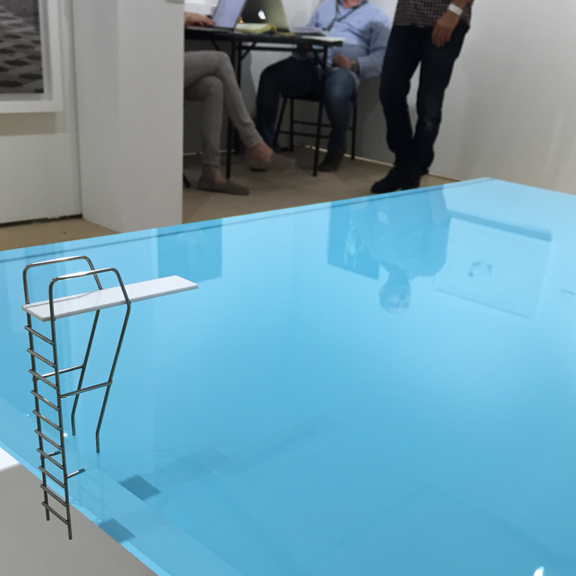
Fictional works set in the future use technology as the crux of their imagined worlds. From the possible to the farfetched, from the clunky switches and functional grey of classic 1960s Lost in Space to the Apple Store glass and white surfaces of 2013’s Oblivion, these visions form an integral part of a work of futuristic fiction. How well do fictional ideas of technological development work and can such futures come to pass? Consider this a review of the ideas about technology, digital culture, and the future in Spike Jonze’s 2013 science fiction film Her.
Her uses the backdrop of a near-future Los Angeles to explore the relationship between a man named Theodore and an artificial intelligence named Samantha. While the developing love story between man and machine is the heart of the film, Her extrapolates off current technology and uses it to comment on human interaction and critique modern internet usage. Her is a world of a casual internet, stripping devices and computers down to basic functionality in order to raise questions of how much do people truly understand each other and the machines they use daily.
As befits a film where one of the main characters is a machine, Her develops a particular vision of a technological future into the core of its fictional world. Current trends are moving towards pervasive technology imposing on the physical world, with wearable devices already here in the form of Google Glass and the recently unveiled Apple Watch. Mobile devices, the way many people now access the internet, have reversed a trend towards small phones that once so dominated the market. Samsung’s Tab 4 phablet is hardly pocket sized while the newly released iPhone 6 plus has taken some criticism for its size but not enough to stop Apple from reporting healthy sales in the first week of release. The perceived stigma of walking around with a giant pad mashed to your head that so crippled the Nokia N-Gage has faded in favor of a growing preference for big screens and more options—even if those options aren’t always used.
The future world of Her goes in the opposite direction, divorcing the outward trappings of technology from daily life. From a lack of dangling iPod earbud cords to an absence of tablets or even iPhone sized smartphones, the technology in Her is unobtrusive. Theodore carries a small, thin, unbranded folding device with a camera and screen, and primarily interfaces with the machines of his world with voice commands picked up through a small earpiece. Perhaps the most notable physical aspect of Spike Jonze’s vision of a near(ish) future is that society has dispensed with the keyboard. Even onscreen keyboards are missing in Her‘s world. Everything throughout the film is operated by voice, motion or touch, with the interface relaying back information by voice most of the time. Stylistically it was likely a decision to minimize the endless typing and sitting in front of a monitor that characterize films with a computer as part of the main plot. Watching someone type for long stretches is rarely enthralling movie making, which some films compensate for by utilizing the common convention of characters saying aloud what they’re typing, a habit I have seen in absolutely no one. Jonze does away with the keyboard and most of the time the need to look at a screen. The idea is in tune with the slick futures presented by commercials for the digital personal assistants Siri and Cortana. Yet could such a completely keyboard-less operating environment work?
In a completely unscientific check of internet sources, 250-300 words per minute is generally accepted as average adult reading speed. 150 to 160 words per minute is a basic metric for audiobooks. For comparison the speed of Theodore’s voice emails near the start of the film are at about 150 words a minute. For casual browsing of the internet, it is still faster and more convenient to read in order to sift through information. Reading on a screen requires less effort to go back, edit and reread any correspondence. While reliance on a voice interface is useful for commands, it is inefficient in a work environment, particularly ones that require a lot of reading or data management. Privacy is another concern with a voice interface. While Jonze’s cinematic goal may have been to show a world where everyone was talking–just not to each other–in practice voice controls would be problematic. Consider a subway full of people composing personal emails or simply muttering, “Delete. Save. Delete. Delete.” on the morning commute. However, voice commands are more than useable for the kind of conversational banter and short question and answer discussions that digital assistants can manage in private—the kind of insular, casual, unhurried future Her develops.
Her‘s portrait of a casual, pervasive, yet less obtrusive technological future is intriguing, but its primary function is to set the stage for Theodore’s relationship with Samantha, his artificially intelligent Operating System, which has some interesting critiques and questions imbedded within. Like most people, Theodore is not very technologically inclined and purchases the OS after seeing an advertisement. While installing the OS he glances at a thin paper manual and then tosses it away—and lets be honest here, who has read the manual for their smartphone? He is relatively unsure of what he is getting in to and is often surprised by Samantha’s capabilities. His incredulous reactions reflect the fact that most users do not utilize their devices to their fullest extent, and ever increasing advances continue to widen the gap between potential and application.
It is in Samantha initial relationship with Theodore that she most closely resembles her real world analogues, Apple’s Siri and Microsoft’s Cortana. The modern digital personal assistant is new, yet the idea of a female voice guiding humans is a trope dating back to at least to the female voices of Computer, the controlling intelligence of the City of Domes in 1976’s Logan’s Run, and of Mother, the spaceship Nostromo’s main computer in 1979’s Alien. Microsoft’s Cortana is named for the artificial intelligence in the Halo game series who serves as Master Chief’s guide and by extension the player’s tutor in the game-world. The trope is continued today by commercials for the Ooma phone service, where a bright young female voice guides a generally clueless man through using a piece of technology. The idea is one that is entrenched in digital culture, even if the Ooma commercial flashes a blunt onscreen caveat that, “Ooma doesn’t really talk like that, duh.”
Towards the end of the film Samantha reports an upgrade that allows her and other OS’es to move past using` matter as their processing platform. Theodore, too caught up in the dawning realization that Samantha is involved with other people, accepts her statement without comment. Updates are an everyday part of life, with technology advancing daily, yet they often fly under the radar, only announcing themselves when complete. As the world shifts towards smartphones and tablets as the interface of choice, the most popular options come without the ability to tinker under the hood or replace components. When the option does exist, it is rarely taken advantage of. For all that technology offers, most users are content with basic functions and only take notice when an upgrade breaks their device, as happened with Apple’s iOS 8.01.
The rapid advance of technology compared to humanity’s incremental evolution as a biological species underlines the most radical idea that Her hints at: that of a technological singularity, a point in the near future when machines will blossom into a true intelligence, formidable, alien, and vastly superior to that of their creators. The concept has been around in film for some time, such as the origin of Skynet in The Terminator and the titular supercomputer in Colossus: The Forbin Project for example. The ramifications of such an event has been explored by futurists like Ray Kurzwiel in his book The Singularity is Near. It’s the kind of potential, out there possibility that is part of digital culture, even if its not the kind of thing Apple wants consumers to consider when asking Siri about the nearest Chinese restaurant.
Her manages to make the event intimate by framing it within the context of a love story and the movement of individuals drifting apart as one grows and the other remains static.
It is Her‘s best use of technology to comment on the human condition. Ultimately, the artificial intelligences chose to leave limited humanity behind. While the impact of such a machine transcendence is primarily emotional in Her, the advent of true artificial intelligence would send shockwaves throughout all segments of society.
The near future of Her ultimately feels like an alternate reality where social media and the internet never quite captured the imagination and online usage remained in a strange 1990s limbo of chatrooms and email, minus the mind bending graphics of Geocities home pages. It is a world of the casual user, meant to streamline a very complicated modernity to tell a story and not alienate a still significant segment of the population who isn’t that big into the internet. Her assumes little on the part of its viewers, reflecting its unobtrusive design themes and the everyman Theodore’s use of devices and technology. It’s also not an unimaginable future, although with any luck the high-waisted pants without a belt featured in the film won’t become a fashion trend, although messenger bags and clean public transportation wouldn’t be too bad at all.
Her, Directed by Spike Jonez, 2013. Los Angeles: Warner Bros. Studios.



